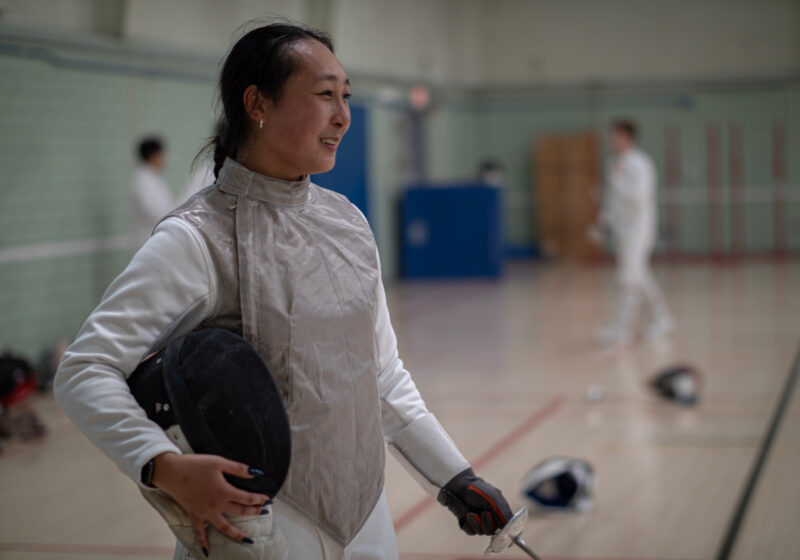The University of Rochester Theatre Program takes on a modern interpretation of Shakespeare’s “Othello” and does an excellent job of capturing the intricacies of the renowned tragedy.
Director Nigel Maister carefully explores the conversation of race that threads throughout “Othello.” While Othello holds a place of high power as a Venetian general, he is described as a “moor” (an archaic term associated with dark-skinned appearance), isolated from his associates and disapproved of by his father-in-law.
“It’s one of those plays that really does encapsulate the Black experience in majority white spaces,” says sophomore Onosejere Ughenin, who plays Othello.
Along with the story’s overarching connection to race, Ughenin credits the bravado intrinsic to the role for pushing him out of his comfort zone. The show’s frequent portrayal of violence, both through direct contact and the guns added, call for a layer of separation between character and performer — often a difficult state to tap into.
Junior Anna Bakina plays antagonist Iago, who is male in the original text. This gender swap was a calculated choice by Maister, providing a contemporary perspective on the already-malleable script. While Shakespeare is not known to have written weak women, first-year Madeleine Christopher (Desdemona) claims that the inclusion of a female antagonist as a high-ranked military officer challenges both Elizabethan and modern-day expectations of women.
While the language of the play is still deeply gendered, such as female characters being labeled “whores,” Christopher’s performance of Iago, a character not beholden to these expectations, invites a discussion of the internalized misogyny that both women and men may face in the modern day. Bianca, played by sophomore Mikaila Son, speaks to this throughout the show by comparing women to food and men to stomachs, as well as balancing her devotion to both her Lady Desdemona and her villainous wife Iago. The dynamic between Iago and Biananot only allows for a complex perspective on womanhood, but also that of sexuality, naturally introducing queer characters into the narrative.
As a theater-goer adjusted to the constant portrayal of female actresses as male characters, it was refreshing to see this dynamic switched, even if solely through a few pronoun adjustments and costume switches. For Bakina specifically, it was wonderful to see the contrast in her performances this school year between the female-adapted Iago and her performance as Grandpa in TOOP’s “You Can’t Take It With You.”
“Othello” runs for 3 hours and 15 minutes with one intermission, keeping the audience enraptured by utilizing a malleable set and entertaining blocking. The production managed to eloquently portray Shakespearean language, and make it understandable and digestible to the audience for the entirety of its long running time.
The set was minimalistic but fluid throughout each scene through the use of subtle elements such as curtains, bars and situational blocking. Iago would turn the metal bars, leaning into her manipulation throughout the narrative, shifting the set more and more as the play progressed. The production began with just a blackout set and a red curtain with the Lion of Venice projected upon it, and behind the large velvet curtain was a concrete wall with a wire fence lining the top. As the plot unfolded the set was stripped away — using the curtains to emulate the dark seas of a storm before eventually tearing them down.
The usage of backroom dialogue and entrances from all across the theater kept the staging dynamic and allowed the audience to feel more immersed. Along with the set design, the show’s lighting paired excellently with the production’s rawness. The lights behind the concrete wall were kept muted — detaching from the audience and even the performers but maintaining the solemn tone. Front-of-stage lighting lent well to Shakespeare’s soliloquies, while small touches such as the warmth from Desdemona’s lamp and the flashes of gunshots provided allure and maintained edge-of-seat attention.
The vilification and martyrdom of Othello is represented primarily in the last act, where Othello starts to be “poisoned” by jealousy. Jealousy is a disease that seizes Othello and leads to him falling into convulsions while the instigator of his jealousy, Iago, simply watches, refusing Cassio’s assistance. He starts clad in royal garments, but slowly shifts into earth-toned clothes as jealousy is planted into his mind, which shifts to dark tones as his disease takes him over. When he kills Desdemona in a fit of jealousy he is clad in white except for a black shawl draped over his body.
Once he realizes his mistake, he pulls off the shawl and sets it down next to the corpse of his wife. At the end of the play, he picks up her body and brings her to what will be the scene of his own suicide at the back of center stage, bright fluorescent light focusing on them and casting them in a heavenly glow. The music starts to build and grows louder as a medic walks up to their bodies and throws the white sheet of divinity onto them.
In whole, “Othello” is a must-see production, an excellent reflection of the prowess of Todd’s creative and technical skill sets. Particularly with its adaptation to a contemporary setting, the performance provides something to take home for any audience member and leaves one stunned, impressed, and hungry for more. Othello is running at the Sloan Performing Arts Center until April 27, with free tickets for students at the door.






